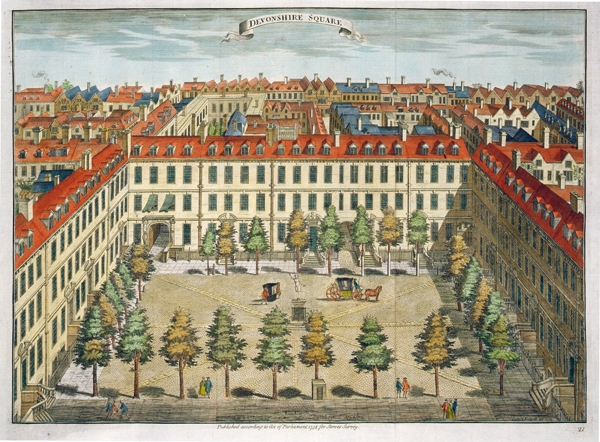One of the pleasures of my week is walking across St James’s Square. The slightly furtive sense of trespassing as one opens the ironwork gates; the decision as to whether or not to follow the circuit of gravel paths or go straight across the grass; the equestrian statue of William III and readers from the London Library eating sandwiches. Although the surrounding architecture is an odd mishmash, the shape of the square and its urban form preserves a strong sense of its original 17th-century layout.
St James’s Square plays a prominent role in the narrative of Todd Longstaffe-Gowan’s magisterial account of the ups and downs of the London square. It was Henry Jermyn, Earl of St Alban’s, friend and ally of Henrietta Maria, who first laid it out immediately after the Restoration, following the example of the squares he had seen in Paris and Madrid. His aim was to create a public space ‘for the conveniency of the Nobility and Gentry who were to attend upon His Majestie’s Person, and in Parliament’.
It was St James’s Square which was first enclosed by Act of Parliament in 1725, allowing the residents ‘to clean, repair, adorn and beautify the same, in a becoming and graceful manner’. Charles Bridgeman, the landscape gardener, was employed to create a circular basin of water in the middle, which helped in fire prevention.
Following the example of Lord St Alban’s, a number of builders, speculators and fellow aristocrats laid out squares in the late 17th century, including Southampton Square, which became Bloomsbury Square, Soho Square, which was built on land leased from Lord St Alban’s by Joseph Girle of Marylebone, a brewer, and Golden Square, which was built to plans approved by Christopher Wren.
The great age in the development of the square was the early 18th century when the West End was developed round a sequence of squares north of Piccadilly, including Hanover Square, developed by the Earl of Scarbrough, Cavendish Square, planned by John Prince, surveyor to the Earl of Oxford, Berkeley Square and Grosvenor Square with its ‘wildernesse worke’ at its centre. These stately urban developments were beautifully depicted in engravings by Sutton Nicholls and admired by foreign visitors.
The early history of squares has already been much studied in classic works on London town planning, including Steen Eiler Rasmussen’s London: The Unique City and John Summerson’s Georgian London. Where Longstaffe-Gowan scores is in his superabundant knowledge of the subsequent history of squares: the way in which the model was translated to the inner suburbs, including Islington and the East End (Arbour Square, York Square and Tredegar Square); the planting of their gardens; the efforts which were made in the 1840s and 1850s to open the gardens to more public use; the introduction of lawn tennis in the late 1870s; and the modelling of Leicester Square on the French place (the planners of its latest redesign would do well to study how it looked in the 1880s).
St James’s Square was laid out as a garden with arbours by John Nash and suffered the indignity of being handed over to the American YMCA during the first world war. They constructed a 110-bedroom Washington Inn in the middle. Longstaffe-Gowan tells the story with a rich use of maps, photographs and contemporary quotations.
The issue of how to preserve London squares remained a matter of lively public discussion throughout the 20th century. During the 1920s, they began to be redeveloped, as when Mornington Square was taken over by the Carreras Cigarette Company and Beechams Pills proposed the wholescale redevelopment of Brunswick and Mecklenburgh Squares. This led to the establishment of a Royal Commission on London Squares in 1927 and in turn to the London Squares Preservation Act of 1931.
But squares were still regarded by many as enclaves of privilege, and during the second world war the opportunity was taken to abolish their railings. The removal of the railings in St James’s Square was regarded as a ‘barbaric act of socialism’ and the central garden of the square was handed over to the Auxiliary Fire Service for the planting of vegetables.
Squares remain a live issue in town planning. Longstaffe-Gowan refers at the end of his account to the battle over the development of Chelsea Barracks. This saw a confrontation between those who wanted the development of high-rise apartment blocks surrounded by swathes of grass, and the Prince of Wales, who advocated the low-rise reconstruction of traditional street forms.
For centuries, the square has provided a caesura in the vocabulary of urban density. As in St James’s Square, it affords a small place of escape for the lunchtime crowd. It is a space of true value to the life of the city.






Comments